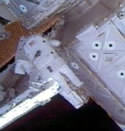
Image credit: NASA
Astronauts Ken Bowersox and Don Pettit spent more than six hours working outside the International Space Station today to wrap a few upgrades. Because NASA will be switching to two-astronaut teams shortly, this will likely be the last spacewalk for several months – one astronaut needs to stay on board the station during any walk for safety. The current crew has been on board since November, and was supposed to return some time in March, but the Columbia disaster has pushed their return back indefinitely.
Expedition 6 Commander Ken Bowersox and NASA Science Officer Don Pettit reconfigured critical power cables and continued the external outfitting of the International Space Station today during a 6 hour, 26 minute spacewalk designed to complete a number of get-ahead tasks for future ISS assembly.
Taking advantage of the final days of a three-man presence on the ISS before the new Expedition 7 crew is launched, Bowersox and Pettit began the second spacewalk of their increment at 7:40 a.m. CDT (1240 GMT). It was the second spacewalk for both Bowersox and Pettit, the 51st spacewalk for ISS assembly and maintenance and the 17th spacewalk staged from the U.S. Quest Airlock. Flight Engineer Nikolai Budarin helped the crew suit up and monitored ISS systems from inside the Destiny Laboratory during the excursion.
Bowersox and Pettit set out immediately to set up tools and tethers, and quickly went to work on separate tasks. Bowersox reconfigured electrical connectors at the interfaces between the Starboard Zero (S0) Truss and the two trusses flanking it, the Starboard One (S1) Truss and the Port 1 (P1) Truss. The connector work will insure that additional protection is in place to prevent the inadvertent release of the truss segments from the S0 Truss through the trusses? Bolt Bus Controller system. Bowersox also inspected a faulty heater cable on the P1 Truss Nitrogen Tank Assembly but found nothing unusual.
While that work was being conducted, Pettit replaced a power relay box in the Mobile Transporter railcar system, which has experienced some electrical problems in recent weeks.
Both spacewalkers then made their way to the Z1 (Zenith One) Truss, where they successfully rerouted power cables to two of the four Control Moment Gyros (CMGs) that provide orientation control for the ISS from the U.S. segment. One CMG failed almost a year ago, and the cable reconfiguration to CMGs # 2 and 3 will prevent both from being disabled in the unlikely event a power failure occurs. The ISS can be properly oriented with just two CMGs in operation. A replacement for the failed CMG will be flown to the ISS and installed on the first post-Columbia shuttle mission, STS-114.
Bowersox and Pettit pressed ahead to install two so-called Spool Positioning Devices on fluid quick disconnect lines for the heat exchanger on the Destiny Laboratory. The devices help keep internal seals and moving parts from experiencing internal leakage as ammonia flows through the station?s cooling system.
With that completed, the two station crewmembers ventured to the S1 Truss to secure a thermal cover on the truss? Radiator Beam Valve Module, which controls the flow of ammonia to the truss? heat-rejecting radiators.
One final task awaited Bowersox and Pettit — the deployment of a balky light stanchion for the handrail cart on the S1 Truss that would not unfurl during the previous spacewalk by the two crewmembers in January. The stanchion proved to be just as stubborn this time, but Pettit used a hammer to tap the stanchion free from its stowed position on the 10th try. A light was then installed on the stanchion, giving the truss the illuminating capability it needs to assist future spacewalkers.
With all of their work completed, Bowersox and Pettit retrieved some tools for future spacewalks from external locations and returned to Quest to complete their spacewalk at 2:06 p.m. CDT (1906 GMT).
The crew will spend a quiet day tomorrow relaxing before resuming its complement of scientific research and routine maintenance work on board the ISS Thursday.
Meanwhile, Expedition 7 Commander Yuri Malenchenko and Flight Engineer/NASA ISS Science Officer Ed Lu completed final preparations before traveling to the Baikonur Cosmodrome in Kazakhstan tomorrow from their training base in Star City, Russia to inspect the Soyuz TMA-2 vehicle in which they will be launched on April 26 to begin a six-month mission on the ISS.
Original Source: NASA News Release
